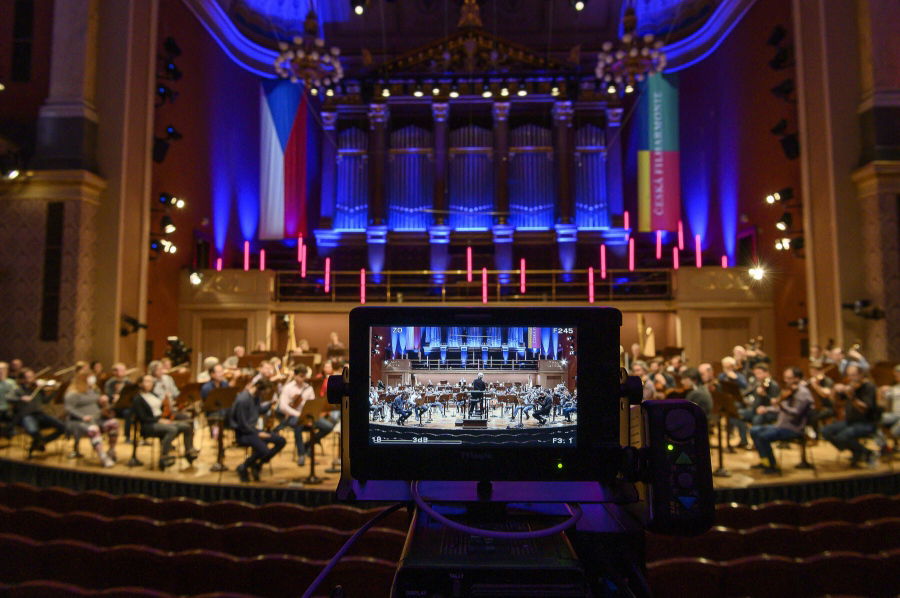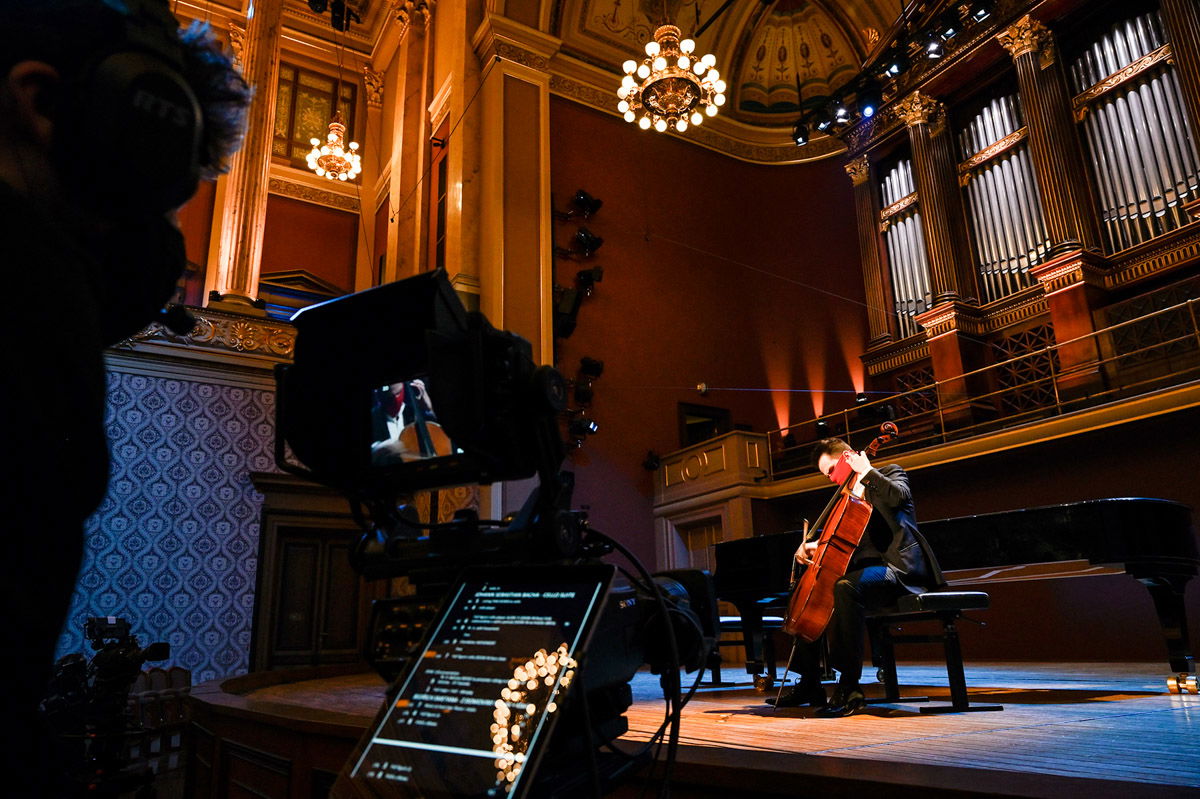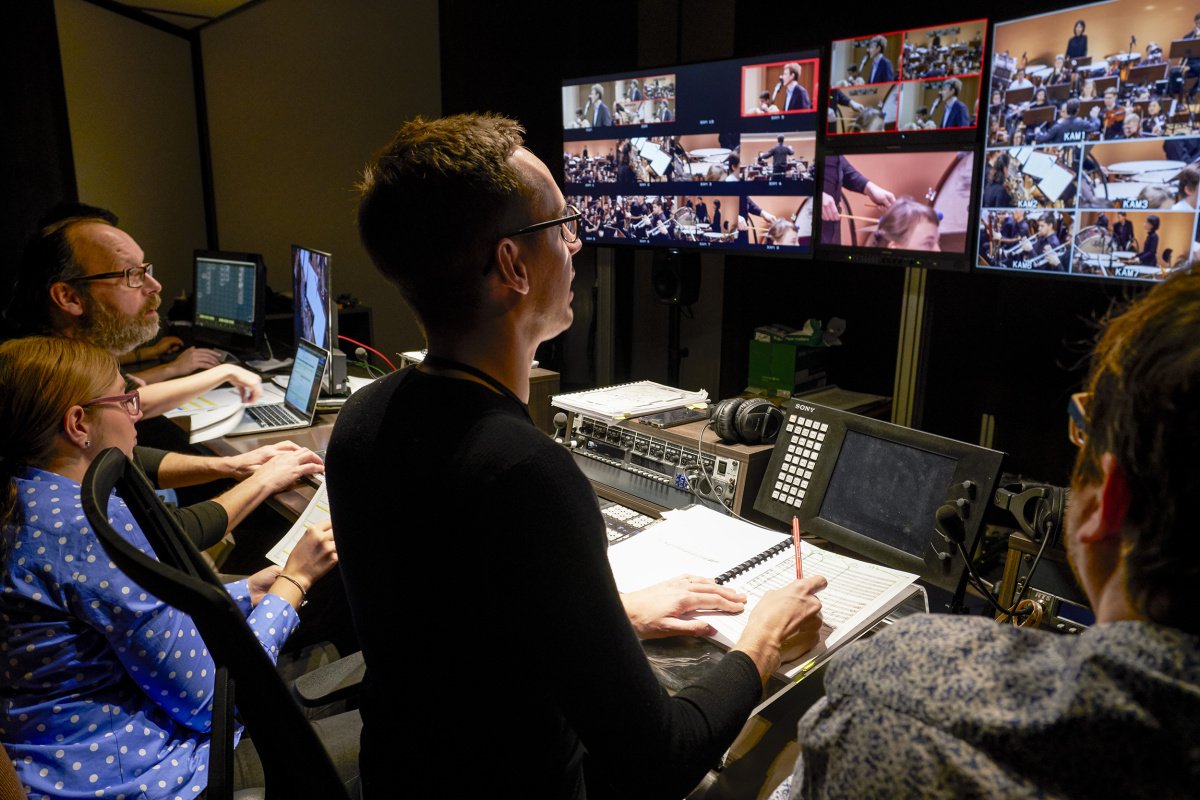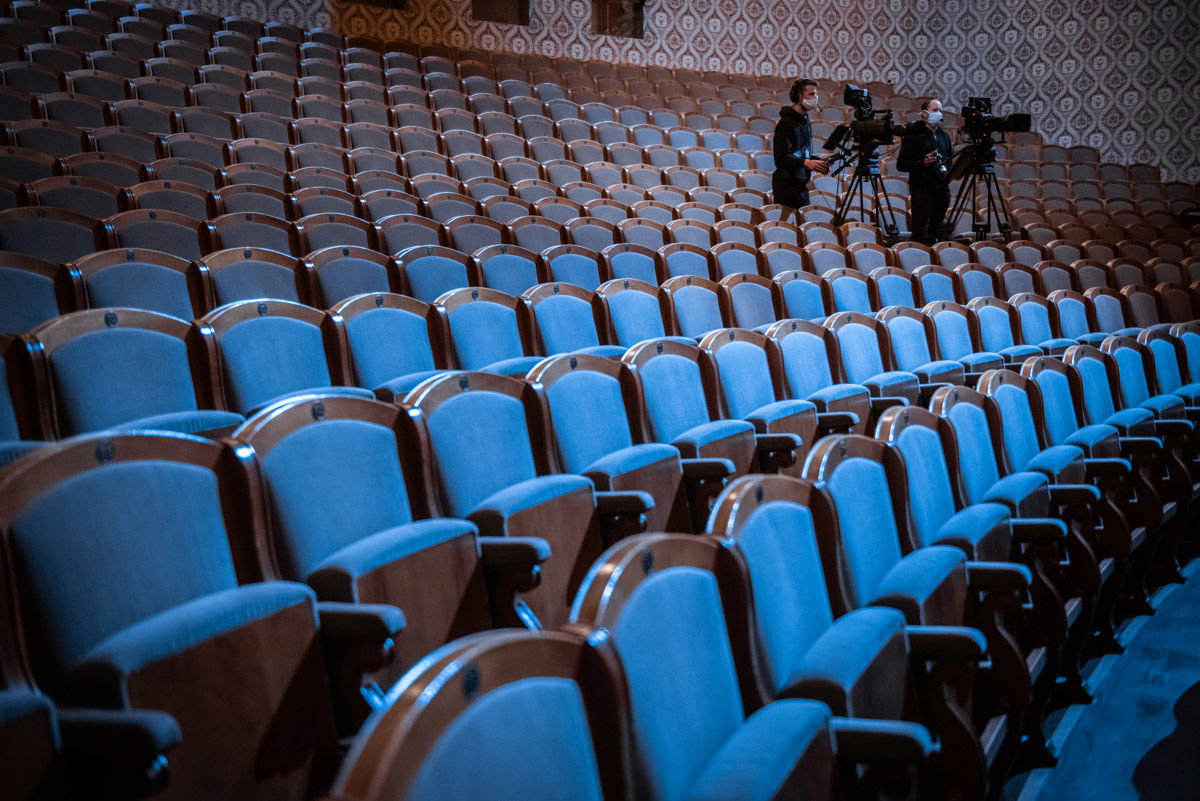Czech Phil Media Are Transporting the Dvořák Hall to Every Screen
The third millennium is in full swing at Rudolfinum. The Czech Philharmonic has significantly expanded into the world of modern technology, the result of which is the Czech Phil Media project. This primarily covers the operation of the new audiovisual studio in the Rudolfinum’s Dvořák Hall and the path of recorded materials to the television, computer, tablet, and phone displays of the music-loving audience. The opportunity to offer the audience a live broadcast of the concert proved to be invaluable at the time when the halls were closed.
20.11.2023
|
Author: Jakub Kožíšek
The Dvořák Hall is undoubtedly one of the most beautiful concert halls in Central Europe, but its capacity is limited. Subscription and special concerts of the Czech Philharmonic are regularly sold out under normal conditions and the same often happens with educational programs. Not to mention the fact that the orchestra has many fans outside of Prague that cannot enjoy the music as often as they would like.
“In Prague, we already play each program three or four times and we cannot add more dates. Our educational capacities and community work are at their maximum,” the chief manager of the Czech Philharmonic, Robert Hanč, noted. The Czech Phil Media project is the solution to this situation.
The brand covers the recording, distribution, and related communication activities of the Czech Philharmonic. In the current phase, this primarily concerns the operation of the new audiovisual recording studio in the Rudolfinum’s Dvořák Hall, the production of audiovisual recordings and their distribution to audiences in the Czech Republic and abroad.
This has proven to be even more important in the past months than anyone could have imagined. Only thanks to the technical ability to provide a live broadcast of the concert, the Czech Philharmonic was able to organize a spring series of benefit concerts, which not only delighted hundreds of thousands of classical fans, but also raised almost 9 million Czech crowns for charitable purposes.
In addition, the Advent series “Česká filharmonie živě u vás” (“The Czech Philharmonic Live At Your Place”), which is intended as compensation for canceled concerts and to encourage the public in difficult times, is filmed by Czech Phil Media technicians and staff. In both cases, it is appropriate to thank the Czech Television and other partners without whom the good cause would not have been possible.
A Top Orchestra with Top Technology
However, regular visitors to the Czech Philharmonic concerts could not fail to notice this earlier when they were still allowed to visit the halls in person. A couple of times a year, a cameraperson sits in the middle of the Dvořák Hall, microphones abound among the musicians, Pavel Ryjáček’s voice begs for “maximum silence in the hall”, the lighting changes and, perhaps, the atmosphere in the auditorium changes: a recording is being made.
When filming concerts, there are up to nine cameras on duty, some of them on rotating robotic heads which work in ultra-quiet mode so as not to disturb the audience in the hall. They are operated by experts in the field of classical music recording, and have the highest quality technology from Sony at their disposal.
It is no exaggeration to say that the one hundred and thirty years old Rudolfinum has grown with hi-tech equipment. In the bowels of the Dvořák Hall, the very first television studio in the Czech Republic, capable of broadcasting in 4K resolution in HDR color mode, was created. For lovers and connoisseurs of technology, a few details can be briefly mentioned:
- The studio is equipped with seven SONY HDC-P43 broadcast 4K cameras and two SONY HDC-4300 cameras; the camera system is fully flexible – up to five cameras can be man-operated. Technocrane and other movement elements are used for selected concerts.
- The visual direction uses SONY products, including two four-channel recording servers. Sound management is equipped with Sequoia and ProTools recording software and Solid State Logic, Duality 72 Channel mixing desks. Neumann, Schoeps and DPA microphones are used.
Translated into the language of the laypeople, this means that the Czech Philharmonic is becoming a pioneer in the field of new technological formats and currently has a technology comparable to the Berlin Philharmonic, whose digital concert hall inspired the entire project, at its disposal.
Czech Phil Media recording studio in Rudolfinum
Filming of the educational programme "Four Steps to the New World: Shostakovich's Fifth"
Photo: Petr Kadlec
Ukázat další fotografie

Czech Phil Media recording studio in Rudolfinum
Photo: Petr Kadlec

Czech Phil Media recording studio in Rudolfinum
Photo: Petr Kadlec

Czech Phil Media recording studio in Rudolfinum
Photo: Petr Kadlec

Czech Phil Media recording studio in Rudolfinum
Photo: Petr Kadlec

Czech Phil Media recording studio in Rudolfinum
Photo: Petr Kadlec
1 / 6
Czech Phil Media recording studio in Rudolfinum
Filming of the educational programme "Four Steps to the New World: Shostakovich's Fifth"
Photo: Petr Kadlec
2 / 6
Czech Phil Media recording studio in Rudolfinum
3 / 6
Czech Phil Media recording studio in Rudolfinum
4 / 6
Czech Phil Media recording studio in Rudolfinum
5 / 6
Czech Phil Media recording studio in Rudolfinum
6 / 6
Czech Phil Media recording studio in Rudolfinum
To Promote Even Lesser-Known Czech Composers
The main long-term goal of the Czech Phil Media is to make a unique sound of the first Czech orchestra available to the whole world. For this purpose, the studio has already been in full operation several times, in addition to the extraordinary “coronavirus” concerts, mainly programs with chief conductor Semyon Bychkov were filmed, but also, for example, an evening with the current music director of the London Symphony Orchestra and former head of the Berlin Philharmonic, Sir Simon Rattle.
As far as the repertoire is concerned, the plan is definitely not only the trio Dvořák – Smetana – Janáček although it is in the greatest demand abroad and the Czech Philharmonic will not refuse it in any case. “Our long-term intention is also to promote other Czech composers’ works, for example, by Bohuslav Martinů, Josef Suk, Vítězslav Novák or Miloslav Kabeláč, or the less frequently performed and recorded works of Smetana and Dvořák,” Vojtěch Šafařík, head of the recording projects department of the Czech Philharmonic, explains.
“In addition, of course, titles from foreign composers such as Mahler, Shostakovich or Tchaikovsky are also selected for recordings as well as less frequently performed ones such as Luciano Berio or Henri Dutilleux. However, what the recordings from the Czech Phil Media collection have in common is still first-class quality, both in terms of interpretation and technical aspects,” he adds.
If, in the first 125 years of its history, the Czech Philharmonic scored primarily with audio recordings, it can be expected that the orchestra’s footprint will be highlighted in the area of video as well now. “It is important that the Czech Philharmonic itself is the producer of the audiovisual recordings for the Czech Phil Media collection, which guarantees direct supervision over the content and quality for it,” Šafařík said.
Czech Phil Media - Benefit concerts in Rudolfinum
Ukázat další fotografie

Czech Phil Media - Benefit concerts in Rudolfinum
Photo: Petr Chodura

Czech Phil Media - Benefit concerts in Rudolfinum
Photo: Petr Chodura

Czech Phil Media - Benefit concerts in Rudolfinum
Photo: Petr Chodura

Czech Phil Media - Benefit concerts in Rudolfinum
Photo: Petr Kadlec

Czech Phil Media - Benefit concerts in Rudolfinum
Photo: Petr Chodura

Czech Phil Media - Benefit concerts in Rudolfinum
Photo: Petr Kadlec
1 / 7
Czech Phil Media - Benefit concerts in Rudolfinum
2 / 7
Czech Phil Media - Benefit concerts in Rudolfinum
3 / 7
Czech Phil Media - Benefit concerts in Rudolfinum
4 / 7
Czech Phil Media - Benefit concerts in Rudolfinum
5 / 7
Czech Phil Media - Benefit concerts in Rudolfinum
6 / 7
Czech Phil Media - Benefit concerts in Rudolfinum
7 / 7
Czech Phil Media - Benefit concerts in Rudolfinum
"And where do I play it?"
It is not only necessary to film the concerts and carefully edit the recordings in post-production, but also to deliver them to those interested on the platforms they prefer to use. In the Czech Republic, the Czech Television is a long-time partner of the orchestra in this effort and regularly includes the Czech Philharmonic concenrts in its broadcasts. The orchestra can also make a significant impact through its social networks.
For foreign countries, the Philharmonic teamed up with one of the global leaders in the field of classical music distribution, the German company EuroArts. The Czech Philharmonic distributes content to television screens and internet platforms around the world, selected concerts are broadcast live. Thus, viewers enjoy the Czech Philharmonic on, for example, the French channel Mezzo TV which has a global reach. The pre-Christmas series of concerts from the end of this year for the German-speaking audience was purchased by Takt1.
EuroArts Music International was founded in 1979 by Bernd Hellthaler, its portfolio currently includes more than 2,500 hours of music performed by the most important orchestras on the planet. “We are thrilled to be able to collaborate with the prestigious Czech Philharmonic and add their extremely high-quality performances to our extensive catalog,” Hellthaler says. “The beautifully filmed concerts are a tremendous asset to both our customers and the global audience,” he adds.
And even chief manager Hanč does not hide his satisfaction from the partnership with Euroarts: “I cannot stress enough how happy we are. Without such great media partners, we would have never been able to reach such a wide audience, including those who, for whatever reason, cannot join us in the concert hall.”
However, it is important that the viewers and listeners experience joy in the end. Broadcasting concerts and educational programs digitally in the highest quality and in cooperation with important global partners is an attempt by the Czech Philharmonic to provide them with the best starting conditions for this.
Take a look behind the scenes!













































